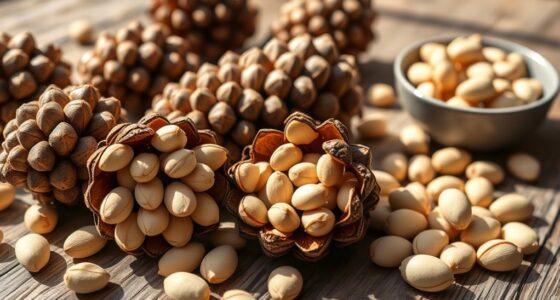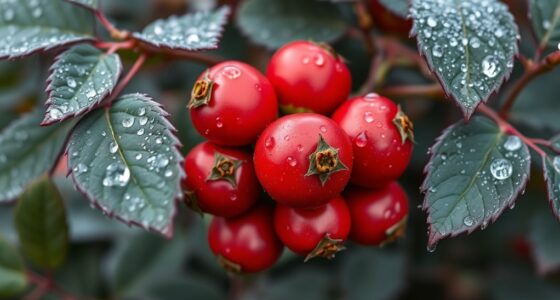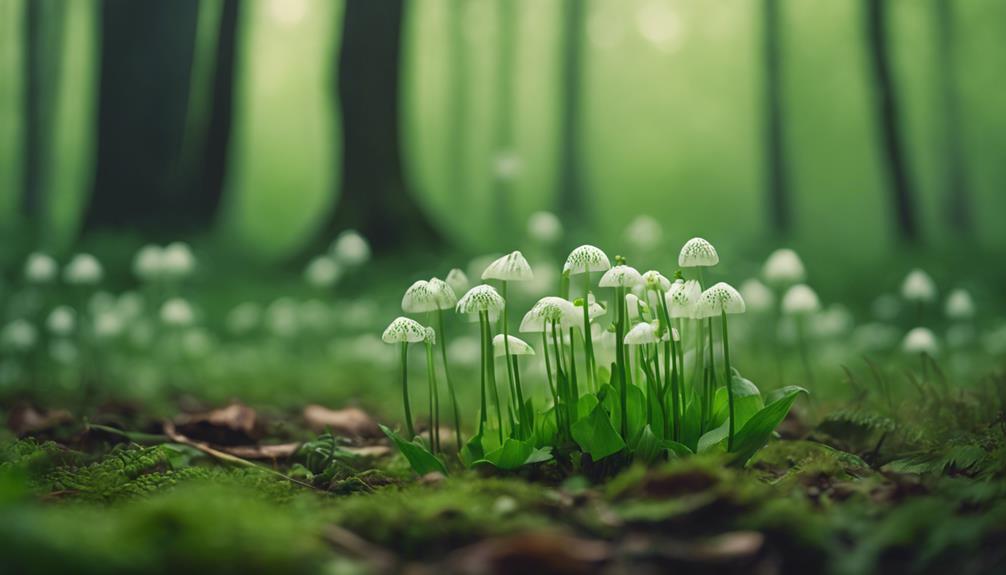You can harvest nutritious pantry staples along riverbanks by digging up burdock roots and cattail tubers. Look for large, hairy leaves and thick roots for burdock, and identify cattails by their brown flower spikes and long leaves. Carefully loosen soil around these plants and extract roots or rhizomes for delicious, free food sources. Proper identification and gentle harvesting guarantee safety and quality. Keep exploring to discover more tips on gathering these natural treasures.
Key Takeaways
- Identify burdock by its large, hairy leaves and thick, brownish root before digging.
- Use hands or tools to carefully loosen soil and extract burdock roots intact.
- Recognize cattails by their tall, reed-like structure and brown flowering spikes.
- Harvest young cattail shoots and dig rhizomes for edible, starchy parts.
- Always verify plant identification to ensure safe harvesting and avoid poisonous look-alikes.

Have you ever wondered what stories lie beneath the surface of a riverbank? These areas are teeming with life and hidden treasures that can become valuable pantry staples once you know where and how to look. Foraging techniques are your best tools here, allowing you to find edible plants that grow abundantly along river edges. Learning how to identify these plants correctly is essential because many have look-alikes that can be poisonous. With a little practice, you’ll be able to distinguish safe, nutritious options like burdock root and cattails from potentially harmful plants.
Start with burdock. It’s a hardy, perennial plant that often thrives along riverbanks and disturbed areas. To identify burdock, look for large, broad leaves with a rough, hairy texture and a heart-shaped or oval shape. Its root is what you’re after—thick, brownish, and resembling a carrot in shape, but with a tougher exterior. When foraging for burdock, use your hands or a digging tool to carefully loosen the soil around the base of the plant. You want to extract the root intact, as that’s the edible part. Remember, the best time to harvest burdock is late fall or early spring, when the roots are most developed. Always double-check your identification because, although burdock is safe when correctly identified, some plants with similar leaves can be toxic. Proper plant identification is crucial to avoid accidental poisoning.
Cattails are another abundant resource along riverbanks. These tall, reed-like plants are easy to spot with their distinctive brown flowering spikes and long, flat leaves. To identify cattails, look for their dense, cigar-shaped flower heads and the long, spear-shaped leaves growing from the base. The edible parts are primarily the young shoots, rhizomes, and flower stalks. Harvest the young shoots in spring, before they get too fibrous, by snapping them off at ground level. The rhizomes, or underground stems, are also edible and can be dug up with a little effort. They’re starchy and can be cooked or eaten raw, though cooking enhances their flavor and digestibility. Be cautious to harvest from clean water sources, as cattails can sometimes absorb pollutants from their environment.
Frequently Asked Questions
Are Burdock and Cattail Safe to Harvest Without Experience?
When it comes to foraging safety, you should be cautious if you’re new to plant identification. Without experience, harvesting burdock and cattail can be risky because similar-looking plants may be toxic. Always learn to accurately identify these plants before digging up roots or harvesting stalks. Proper plant identification guarantees you avoid dangerous lookalikes, making your foraging safe and enjoyable. When in doubt, consult reliable guides or experts to build your confidence.
What Tools Are Best for Digging Burdock and Cattail?
Imagine you’re unearthing hidden treasures beneath the surface—your tools are the key. For root extraction of burdock and cattail, you’ll want sturdy hand tools like a garden fork, trowel, and prying bar. These help loosen soil and carefully lift roots without damage. Choose tools with sharp, durable blades, and handle them with care to guarantee successful harvests. Your hands and these trusty tools become your pathway to nature’s pantry.
How Can I Identify Edible Parts of Burdock and Cattail?
To identify edible parts of burdock and cattail, you should consider their plant habitat and seasonal timing. For burdock, look for its large, broad leaves and root in disturbed soils during late summer to fall, when roots are most developed. Cattails grow in wetlands; harvest the tender young shoots in spring or early summer, avoiding older, brown, or moldy parts. Always verify correct identification before harvesting.
Are There Any Legal Restrictions on Foraging These Plants?
You should check local laws before foraging burdock and cattail, as restrictions vary. Some areas require foraging permits, especially on public lands, while foraging on private property without permission is illegal. Always verify regulations with local authorities or landowners to avoid fines or legal issues. Respect property rights and conservation rules to guarantee sustainable foraging practices and enjoy these plants responsibly.
How Do I Prepare Burdock and Cattail for Storage?
Did you know that burdock roots can stay fresh for weeks with proper storage? To prepare, start with root cleaning, scrubbing away dirt and removing any blemishes. For cattails, harvest stalks and trim the tips. Use storage techniques like refrigeration in airtight containers for burdock, or freeze cooked stalks for later use. Proper preparation guarantees your foraged plants stay fresh and ready for your pantry.
Conclusion
Just like ancient harvesters who relied on nature’s bounty, you can tap into the riverbank’s hidden treasures. Digging up burdock and cattails connects you to a timeless cycle of sustenance and self-reliance. By embracing these wild pantry staples, you become part of a story much bigger than yourself—one that echoes our ancestors’ wisdom. So, venture forth with confidence, knowing you’re cultivating resilience rooted deep in the earth’s enduring legacy.










